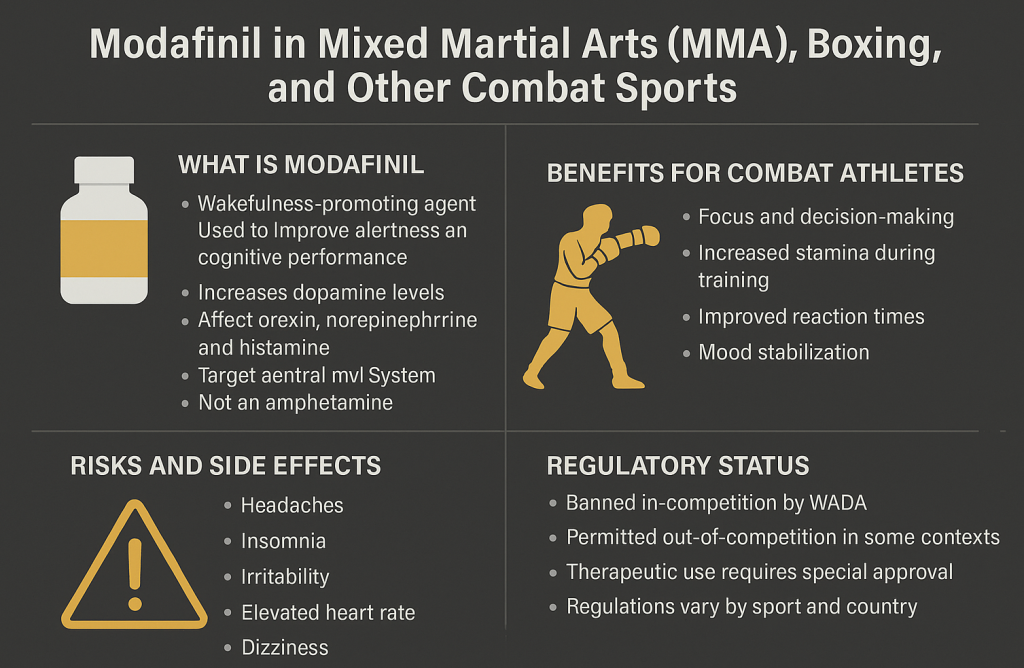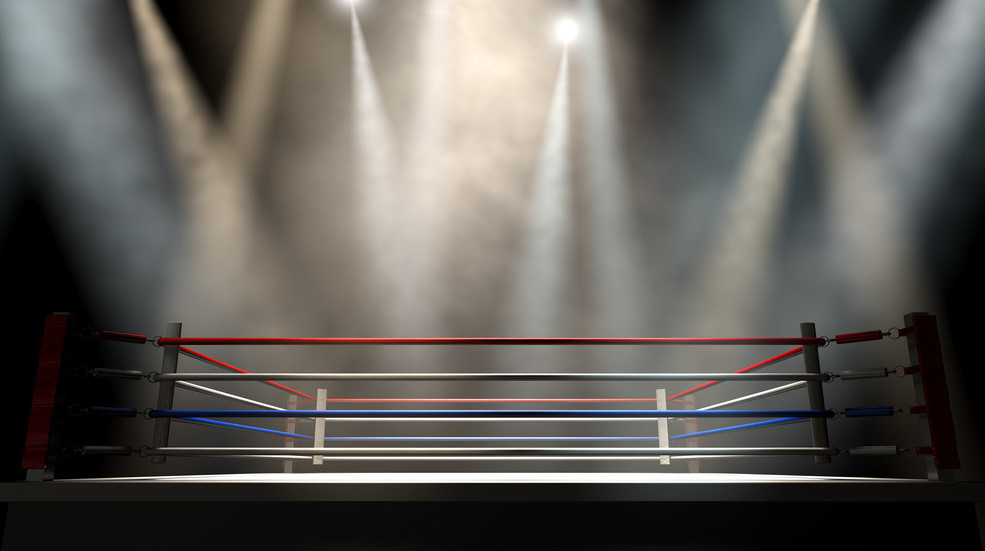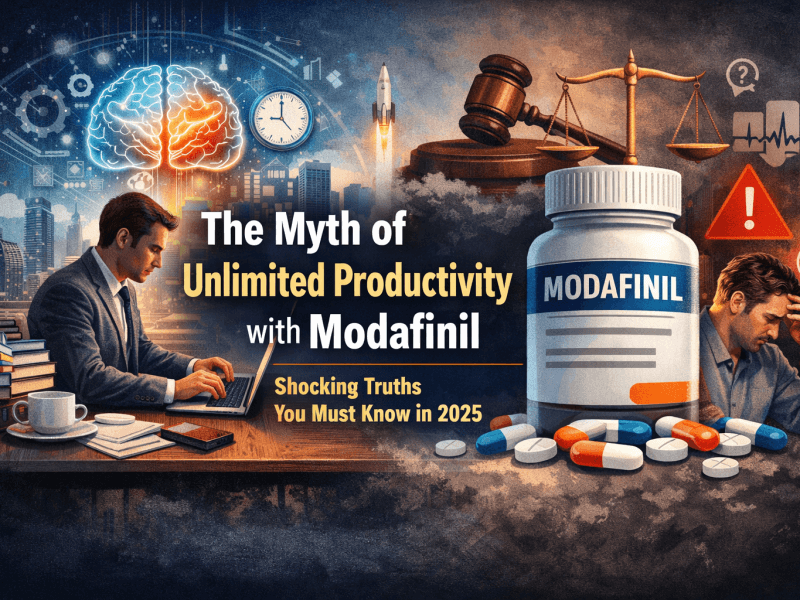Last Updated on 15/09/2025 by James Anderson
Modafinil in Combat Sports
Modafinil has gained significant attention in the world of combat sports, including MMA, boxing, and kickboxing, due to its cognitive enhancing and fatigue fighting properties. Originally developed for the treatment of narcolepsy and other sleep disorders, this wakefulness-promoting agent has found its way into competitive environments where mental focus, reaction time, and endurance are critical to success.
Athletes are constantly searching for legal, ethical, and performance enhancing edges. Modafinil, though often controversial, has been studied and, in some cases, banned, yet it remains a hot topic due to its unique benefits in high stakes combat scenarios.
What Is Modafinil and How Does It Work?
Modafinil is a prescription drug that stimulates the central nervous system. It is not an amphetamine, but it shares many stimulating effects without the typical jittery side effects. It works primarily by increasing dopamine levels in the brain through inhibition of dopamine reuptake. Additionally, it impacts orexin (hypocretin), norepinephrine, and histamine, all of which play a role in alertness and cognitive performance.
For combat athletes, this means enhanced:
- Focus and decision making under pressure
- Stamina during prolonged training sessions or fights
- Reaction times
- Mood stabilization under extreme stress
The Rise of Modafinil in MMA
In Mixed Martial Arts, athletes are tested not only physically but mentally and emotionally. The complexity of the sport blending wrestling, Brazilian jiu-jitsu, Muay Thai, and boxing demands high levels of mental clarity. This is where Modafinil becomes attractive.
MMA fighters often report:
- Sharper mental acuity during sparring and fights
- Reduced perceived exertion, meaning they can push harder
- Improved game planning and memory recall, especially during fight preparation
The UFC and other major MMA organizations adhere to USADA standards, which have placed Modafinil on the monitored substances list. However, therapeutic use exemptions (TUEs) have occasionally been granted under strict medical supervision.
Modafinil Role in Boxing
Boxing, often called the “sweet science,” is a sport that revolves around strategy, timing, and fast reflexes. The mental edge provided by Modafinil can be game changing in a sport where split second decisions determine victory or defeat.
Key benefits for boxers include:
- Sustained attention through 12 round championship fights
- Decreased reaction latency, allowing quicker counter strikes
- Minimized mental fatigue during late rounds
- Improved visual processing, essential for reading an opponent’s body language
However, it is important to note that the World Anti Doping Agency (WADA) lists Modafinil as a prohibited stimulant in competition, which has led to multiple sanctions and failed tests for boxers who used it without clearance.
Cognitive Enhancement and Strategic Thinking
Unlike many other stimulants, Modafinil does not just offer a quick energy boost. It provides long lasting cognitive support, which includes:
- Improved working memory
- Greater pattern recognition
- Better attention span and error detection
This cognitive enhancement is particularly valuable for corner strategists, coaches, and cutmen as well not just the fighters themselves. The ability to process and deliver precise tactical instructions in real time can tilt the balance of a fight.
Use in Training Camps and Weight Cuts

Combat sports training is notorious for long hours, high volume, and demanding weight cuts. Fighters often face sleep deprivation, mental burnout, and dehydration, especially during peak weeks leading up to a bout.
Modafinil offers:
- Increased productivity without added stress on the cardiovascular system
- Improved focus during fasted cardio sessions
- Mitigation of sleep loss effects during the final cut week
- Better mood and psychological resilience
Many fighters resort to Modafinil during their training camps, especially those who need to manage a full time job, long travel schedules, or extreme caloric deficits. However, they often cycle off before competition to avoid testing positive.
Risks and Side Effects of Modafinil in Combat Sports
While Modafinil presents many benefits, its side effects cannot be ignored. Common issues include:
- Headaches
- Insomnia
- Irritability
- Elevated heart rate
- Dizziness
In a combat environment, even minor side effects can have dangerous consequences, especially if a fighter is already under extreme physical stress. Additionally, there are ethical implications and reputational risks involved if caught using it without disclosure.
There is also individual variability in how Modafinil affects athletes. Some may experience a hyper focused, calm state, while others may become jittery or over anxious, which is the last thing a fighter needs during competition.
Modafinil vs. Other Nootropics and Stimulants
Compared to amphetamine based stimulants, Modafinil is:
- Longer lasting (12-15 hours)
- Less habit forming
- Lower in crash potential
Other popular nootropics in combat sports include:
- Phenylpiracetam
- Alpha-GPC
- Caffeine + L-Theanine
- Creatine (for cognitive benefit)
However, Modafinil remains the most researched and potent prescription level nootropic, offering broad spectrum benefits across all domains of athletic performance mental and physical.
Regulatory Status in Combat Sports
As of 2025, Modafinil is banned in competition by WADA, but not always out of competition. This makes timing and pharmacokinetics crucial for any athlete considering its use. Fighters need to understand:
- Detection windows
- Blood and urine half life
- Legal TUE procedures
It’s also worth noting that different promotions and countries have variable regulations. For example:
- UFC (USADA): Banned in competition
- ONE Championship (no WADA adherence): Not always tested
- Regional circuits: Often no testing at all
This patchwork of enforcement leads to inconsistent application, making legal counseling and medical oversight critical.
Conclusion
Modafinil remains one of the most powerful tools for mental performance enhancement in combat sports. While its neurocognitive and endurance benefits are significant, the regulatory, ethical, and physiological considerations must be weighed carefully. Fighters, coaches, and medical teams must work together to determine whether its use is appropriate, legal, and safe, particularly in high stakes environments where career trajectories hang in the balance.
‼️ Disclaimer: The information provided in this article about modafinil is intended for informational purposes only and is not a substitute for professional medical consultation or recommendations. The author of the article are not responsible for any errors, omissions, or actions based on the information provided.
References:
- Hersey M, Tanda G. Modafinil, an atypical CNS stimulant? Pharmacological Advances in Central Nervous System Stimulants. Adv Pharmacol. 2024
- Robertson P, Hellriegel ET. Clinical pharmacokinetic profile of modafinil. Clinical Pharmacokinetics. 2003
- Greenblatt, K., Adams, N. Modafinil. StatPearls Publishing. https://www.ncbi.nlm.nih.gov/books/NBK531476/ . 2025
- Oliva Ramirez A, Keenan A, Kalau O, Worthington E, Cohen L, Singh S. Prevalence and burden of multiple sclerosis-related fatigue: a systematic literature review. https://doi.org/10.1186/s12883-021-02396-1 . 2021.
- Mereu, M., Bonci, A., Newman, A. H., & Tanda, G. The neurobiology of modafinil as an enhancer of cognitive performance and a potential treatment for substance use disorders. https://doi.org/10.1007/s00213-013-3232-4 . 2013
- Ciancio A, Moretti MC, Natale A, Rodolico A, Signorelli MS, Petralia A. Personality Traits and Fatigue in Multiple Sclerosis: A Narrative Review. Journal of Clinical Medicine. https://doi.org/10.3390/jcm12134518 . 2023
- Natsch, A. What makes us smell: The biochemistry of body odour and the design of new deodorant ingredients. CHIMIA International Journal for Chemistry. https://doi.org/10.2533/chimia.2015.414 . 2015
- Hamada, K., Haruyama, S., Yamaguchi, T., Yamamoto, K., Hiromasa, K., Yoshioka, M., Nishio, D., & Nakamura, M. What determines human body odour? Experimental Dermatology. https://doi.org/10.1111/exd.12380 . 2014
- Kaplan S, Braverman DL, Frishman I, Bartov N. Pregnancy and Fetal Outcomes Following Exposure to Modafinil and Armodafinil During Pregnancy. JAMA Internal Medicine. 2021
- Slotnik DE. Michel Jouvet, Who Unlocked REM Sleep’s Secrets, Dies. 2017
- Greenblatt K, Adams N. Modafinil. StatPearls. Treasure Island, StatPearls Publishing. 2019
- Hashemian SM, Farhadi T. A review on modafinil: the characteristics, function, and use in critical care. Journal of Drug Assessment. 2020
- Tanda G, Hersey M, Hempel B, Xi ZX, Newman AH. Modafinil and its structural analogs as atypical dopamine uptake inhibitors and potential medications for psychostimulant use disorder. Current Opinion in Pharmacology. 2021


